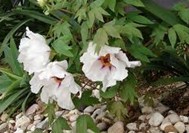Paeonia suffruticosa, the tree peony, is a species of peony native to China. It is known as mudan in Chinese and is an important symbol in Chinese culture. It was first described by Henry Charles Andrews.
Tree peonies are considered to be relatively pest free. Some susceptibility to canker, leaf blight, stem wilt and scale. Ants on peony buds are common and totally harmless. Excellent in borders as specimens or in groups. Also effective as accents or hedges along fences, sidewalks, driveways or walls. Flowers are extremely showy, and foliage remains attractive throughout the growing season, either alone or as a frame or backdrop for other flowering plants. This tree peony species is a deciduous, woody shrub that typically grows 3-5' tall with a 4' spread. The true species features large flowers (6-8" across) with pink to white petals, each petal having a purple basal patch.
Chemistry: P. suffruticosa contains paeonol, galloyl-paeoniflorin, galloyl-oxypaeoniflorin, suffruticoside A, B, C, D and E.
| Catalog | Product Name | CAS Number | Manual |
|---|---|---|---|
| CFN98926 | Paeonol | 552-41-0 | |
| CFN99536 | Benzoylpaeoniflorin | 38642-49-8 | |
| CFN99544 | Paeoniflorin | 23180-57-6 | |
| CFN99589 | Oxypaeoniflorin | 39011-91-1 | |
| CFN99774 | Albiflorin | 39011-90-0 | |
| CFN99624 | Gallic acid | 149-91-7 | |
| CFN98695 | Hederagenin | 465-99-6 | |
| CFN98733 | Astragalin | 480-10-4 | |
| CFN93180 | Methyl gallate | 99-24-1 | n/a |
| CFN97450 | Methyl syringate | 884-35-5 |
A unique collection of 22 natural compounds from Phellodendron Chinense Schneid.
A unique collection of 26 natural compounds from Rehmannia glutinosa (Gaert.) Libosch. ex Fisch. et Mey.
A unique collection of 22 natural compounds from Ziziphus jujuba Mill. var. inermis (Bunge) Rehd.
A unique collection of 30 natural compounds from Citrus reticulata
A unique collection of 50 natural compounds from Panax ginseng C. A. Mey





